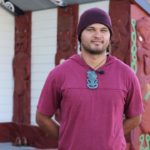
26 Sep Tāmaki Ararau – The many paths of Tāmaki
Cast your mind to the stories of Kupe and Kuramārōtini emerging from a thick mist to discover what we now call home: “He ao, he ao, He aotea-roa”- the land of the long white cloud.
It is clear that our tipuna have mastered the art of transmitting intergenerational knowledge and that particular skill is a key component of our mahi here within the Mātaiao workforce!
Before the age of cars and planes, our ancestors explored this beautiful land by waka and utilised the natural resources just like Kupe who followed the wheke. Ahikā and the people of Auckland travelled by waka using rivers and streams as their main mode of transport. This is reflected in the name, Tāmaki Herenga Waka.
Aboard the esteemed waka Kahakura, our wānanga Mātaiao for Tahuna Torea immersed participants in the same waters our ancestors once traversed upon the waka Tainui. The captain of the Tainui waka, Hoturoa, is the name Manukau originates from – Te Mānukanuka o Hoturoa.
The physical component of our Mātaioa wānanga is always a highlight. A key point of difference in our wānanga is the physical implication of connecting to atua. To fully feel and understand the mauri of atua you must apply yourself in the environment. For example, if you hop in the water or enter the forest you get a holistic connection to Tangaroa or Tane Mahuta. There is always a sense of anxiety but we encourage participants to use language that is intertwined with the environment: “Ka whati te tai, ka pao te torea — when the tide is out, the torea strikes,“ meaning, to ‘seize opportunities when they arise’.
When engaging in our taiao, opportunities present themselves in multiple mediums and during wānanga we reflect on those signs, similar to the wheke spotted by Kupe and Kuramārōtini. When running around Tahuna Tōrea reserve we had seen that the tide was coming in faster than expected. After a group examination of taiao we decided to cut through the reserve to get back on land ASAP. Devices have become the normal safety check when heading into the ocean but sometimes you have to examine the environment for yourself to make the safest decisions. Even though we had done the pre-planning before we headed out, today was not the day or time to take that route.
The wānanga concluded at the summit of Maungarei where participants had an (almost) birds-eye view of the 17.3 km journey we had conquered on foot as a whānau. Meeting atua such as Hinetūiterepo early in the morning and having Whiro whispering in our ears for the rest of the day is only a small window into our experience. As one said, “I cant believe I did that.”
Such experiences deepen our connection to the land and water, prompting us to engage the cognitive skills needed to integrate the physical, mental, and spiritual aspects of the experience.
Keep an eye out for our next wananga, 13-14 October 2024 at Te Pane o Mataaho. Nau mai, haere mai.

Koianake Yates
Endowed with the blessings of Tūmatauenga from birth, Koianake was instilled with traits of humility and resilience and continues to uphold the ancient lores and narratives that foster a deep connection to ngā atua Māori.



